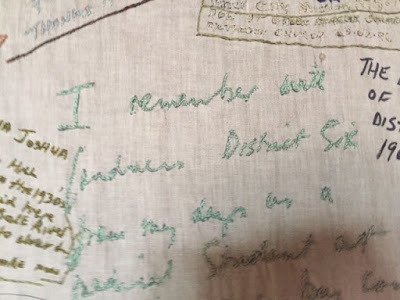I recently
spent a few days in County Cork and Tipperary, as a planned trip to see my
brother and his family. However, as often happens with plans.....things didn’t
quite work out as we thought. My brother is a film editor and goes where the
work takes him. It took him to Amsterdam for the week we had planned our Irish
trip.
We decided
to go anyway, see my sister-in-law and my 2 nephews, and have a couple of days
just wandering around, knowing how enjoyable such wandering can be in Ireland.
Seeing the
family...even without my lovely brother, was great. It is 4 years since we have
seen each other, and surprise surprise....the nephews have grown up ! 21 year old Michael has turned into a
gorgeous, gentle, interesting young man, about to move to Amsterdam ( where he
was born), with his delightful girlfriend Kaylee, for some
adventures. 13 year old Thomas has become a polite, sensible, hard working,
musically talented teenager. It was lovely to spend some time with them.
We always
used to joke about how sitting around sister-in-law Catherine’s kitchen table involved
a never ending pot of tea and a revolving kitchen door, through which various
brothers/sisters/cousin/neighbours would stream.
No sooner
had Mark and I sat down at the kitchen table, with Catherine and the boys and
Michael’s girlfriend, that Catherine’s
eldest brother arrived. It was good to see that despite us not being visitors
for over 4 years, the open door policy continues.
Anyway,
after spending time with family, we wandered off on our own.
We followed
the Wild Atlantic route from Kinsale to Skibbereen. It was stunning.
The colours
of Kinsale will live with me for years. The early morning sunlight made
everything glisten. It was one of those mornings when somethings seems almost
too bright to look at.
We found a lovely cafe for breakfast, drank some
fabulous coffee and wandered on.
We had to
keep stopping for castles,
fabulous views across bays,
incredible bird
sightings
and walks along various beaches.
We were reminded how long journeys
in Ireland take.
Winding narrow roads, driving behind slow farm vehicles, and
stopping frequently to take photos...and just to look, takes its time.
Skibbereen
was our target, and we arrived in time for lunch. It was a truly fascinating
town.
By the mid
1800s, Skibbereen was quite densely populated, with about 400 people to the
square mile. The potato was the staple diet for more than half the population
of Ireland, particularly the poor. Apparently, with the addition of buttermilk
or fish, it provided all the requirements for a healthy diet, although to do
this, it required a man to eat up to 14lbs of potatoes a day !
Anyway....when
the potato blight ( phytophthora infestans ) hit.....people died. It was a
fungal infection which arrived from north America in the autumn of 1845. It
spread rapidly and by 1846 there was a 90% loss of the potato harvest in the
Skibbereen area.
In the cold winter
of 1846 many thousands died of starvation, some in the totally inadequate work
houses, but many, just on the sides of the roads, or hidden away in their tiny
mud cottages. There were a few public works schemes that were supposed to
provide work, and therefore money, for the poor. Thousands involved in the schemes
died as they were so malnourished and sick
that they were unable to earn enough to stay alive.
By 1847,
Skibbereen was being referred to as the centre of the famine.
Disease was rife, “famine fever” covered a
range of diseases, including typhus, relapsing fever or yellow fever,
dysentery, and what became a pandemic of cholera in 1848-9. No one knows how
many died. Bodies were piled into mass graves, relatives too weak to bury,
mourn or to organise funeral ceremonies, died themselves, and were added to the
piles of bodies.
The
population of the area covered by the Skibbereen Union fell by 37,000 between
the census years 1841 and 1851.
It is
thought that at least a million people died in those few years, and within 10
years another 2 million had emigrated. Few from Skibbereen were able to flee
though. People in the poorer areas did not have the means to emigrate.
Many of those who were able to escape went to
America, but first had to leave Ireland to get to England. Thousands flocked to
Liverpool, where most of the trans Atlantic crossings began. The Illustrated London News reported that the treatment of the Irish
by Liverpool parish officers was worse than that given to cattle. It is
estimated that 100,000 Irish famine migrants died in Britain.
At one
stage, famine emigrants who were destitute on arrival in England were classed
as vagrants and deported back to Ireland.
Some parishes offered rewards for information leading to the discovery
of” illegal immigrants”. Nothing changes !
My great
great grandparents, William and Mary Whelan, appear on the 1851 census, in
Liverpool. Their birthplace is listed as “ Ireland”, and their eldest child was
born in Ireland in the mid 1840s. I don’t know where in Ireland they came from,
but they were clearly part of the movement, escaping the famine. Their son, my
great grandfather, was born in Birkenhead. His son, was my grandfather, for those of you that know a bit about my family....the bigamist grandfather.
Our bit of the Whelan family had
escaped, and survived. Due to the fact that William and Mary Whelan survived, our family has spread to England, Australia and New Zealand..... and maybe Michael will re settle in Holland, who knows ? Jessie, my daughter, lives in Liverpool, not far from where William and Mary settled and where my grandfather spent part of his youth.
Our trip to
Ireland was wonderful. We caught up with family, we visited beautiful places,
but the horror of what happened there, not so very long ago was haunting.





































